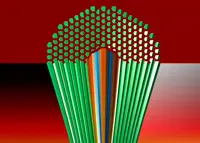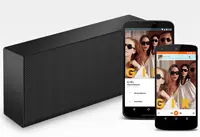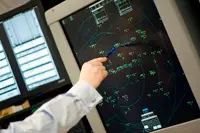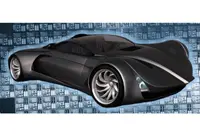Electronics News
Archive : 10 June 2015 год
 Researchers at the University of Southampton's Zepler Institute have manufactured a 11km length of hollow core photonic bandgap fibre. According to the team, this type of fibre has only been made in lengths of hundreds of metres previously.
Researchers at the University of Southampton's Zepler Institute have manufactured a 11km length of hollow core photonic bandgap fibre. According to the team, this type of fibre has only been made in lengths of hundreds of metres previously.
Hollow core photonic bandgap fibre supports bandwidths in excess of 200nm, with a longitudinally uniform loss of approximately 5dB/km at 1560nm. The fibre made at Southampton has a 19 cell core and a five cladding ring structure and was fabricated using a conventional two-stage stack and draw technique.
"Hollow core photonic bandgap fibre has only had niche applications up until now because it was thought that it could not be manufactured in lengths suitable for telecoms applications," said Dr Marco Petrovich a senior member of the team. "Not only have we successfully made a photonic bandgap fibre in a suitable length, we have also engineered it to have the right properties for telecoms applications."
The team says it demonstrated data transmission at 10Gbit/s along the 11km span using direct detection. The results were said to show only 'minor penalties'.
Manufacturing long lengths of photonic band gap fibre is said to be difficult because the nodes and struts that give photonic bandgap fibre its properties are usually on a sub micron scale, with many of nanometre scale.
Dr Petrovich noted: "Our numerical models of the fibre drawing process give us confidence that much longer fibre yields are feasible through further scaling of the process and that much lower loss fibres should be possible."
For more on the activities of the Zepler Institute, click here
Author
Graham Pitcher
Source: www.newelectronics.co.uk
 Frontier Silicon has signed an agreement with Google that will see the inclusion of Google's Cast for Audio technology in the next generation of Frontier's audio solutions, which are planned to ship in the first half of 2016.
Frontier Silicon has signed an agreement with Google that will see the inclusion of Google's Cast for Audio technology in the next generation of Frontier's audio solutions, which are planned to ship in the first half of 2016.
Anthony Sethill, CEO of Frontier's parent company Toumaz Group, said: "Our agreement with Google will provide a major boost to our connected audio business in 2016 and beyond. In recent months, we have benefited from strong market growth and achieved a number of important design wins for our existing connected audio platform. With the addition of Cast for Audio, we expect to drive this growth further."
Cast for Audio – which uses the same technology as the Chromecast video streaming platform – allows users to stream music services directly from the cloud to Cast enabled speakers. Meanwhile, Frontier's technology solution allows consumer audio companies to build connected audio devices, such as Wi-Fi speakers and soundbars, quickly and easily and Cast for Audio is said to be a significant addition to its product portfolio.
Author
Graham Pitcher
Source: www.newelectronics.co.uk
 Air traffic control company NATS is exploring the possibility that TV signals could be used for tracking aircraft, following a proof of concept conducted in conjunction with Thales ATM and Roke Manor.
Air traffic control company NATS is exploring the possibility that TV signals could be used for tracking aircraft, following a proof of concept conducted in conjunction with Thales ATM and Roke Manor.
The two year trial was carried out primarily over London, with a Thales concept demonstrator using signals from the Crystal Palace transmitter. The results of the trials were then validated by Roke Manor. According to the partners, up to 30 aircraft were tracked at any one time at altitudes of up to 10,000ft. However, they add that more planes could have been tracked with the use of additional equipment.
The results of the trial show TV signals could allow air traffic controllers to maintain separation of three or five nautical miles.
Nick Young, NATS system engineer, said: "There are a number of technical and regulatory hurdles to overcome before this could be considered for operational use. Questions around resilience and service standards need to be answered and we'd need to explore formal agreements with the broadcasters, but this is very exciting and we'll be looking to further develop the concept over the next five years."
A second phase of the trial, conducted in Liverpool, showed that TV signals appeared to be less susceptible to interference from wind turbines than traditional radar.
Author
Graham Pitcher
Source: www.newelectronics.co.uk
 Three research projects announced by the European Commission are looking to make electromobility cheaper, more efficient and more reliable. The projects, which will run until 2018, have received €67million in funding. Infineon will lead the projects, which bring together 120 researchers from 15 countries.
Three research projects announced by the European Commission are looking to make electromobility cheaper, more efficient and more reliable. The projects, which will run until 2018, have received €67million in funding. Infineon will lead the projects, which bring together 120 researchers from 15 countries.
According to Infineon, the projects should see electrical systems used in electric vehicles being 20% more compact and lighter, contributing to increased range and lower cost.
The 3Ccar project (Integrated Components for Complexity Control) aims to strengthen the reliability of automotive systems. It will bring together 48 partners from 14 countries, with a budget of €54m.
The OSEM-EV (Optimised and Systematic Energy Management in Electric Vehicles) project, with an €8m budget, is looking to increase the range of electric vehicles. This will bring together 12 partners to pursue intelligent thermal management, includes the cooling system for electric drives, battery life and efficient energy recuperation.
Meanwhile, 10 partners from five countries are working on the €4.5m SilverStream project, which aims to develop an inexpensive electric compact car.
You can find more information about the research projects at www.osem-ev.eu, www.silverstream-ev.eu and www.3ccar.eu
Author
Graham Pitcher
Source: www.newelectronics.co.uk
 Figures released by the AFDEC group within the Electronic Components Supply Network (ecsn) show showed that total monthly billings increased by 2% compared to April 2014. The increase was accompanied by an increase in the book to bill ratio, with the semiconductor and electro-mechanical market sectors leading the way. However, while year on year billings increased, they were said to be 14% down on March 2015.
Figures released by the AFDEC group within the Electronic Components Supply Network (ecsn) show showed that total monthly billings increased by 2% compared to April 2014. The increase was accompanied by an increase in the book to bill ratio, with the semiconductor and electro-mechanical market sectors leading the way. However, while year on year billings increased, they were said to be 14% down on March 2015.
ECSN chairman Adam Fletcher said the 2% growth figure is 'reassuringly' in line with ecsn's forecast for 'improving, low single digit growth over the next three quarters'. He ascribed the month on month drop to a decline in economic growth across the EU, as well as a continued downturn in manufacturing output in China.
Author
Graham Pitcher
Source: www.newelectronics.co.uk

